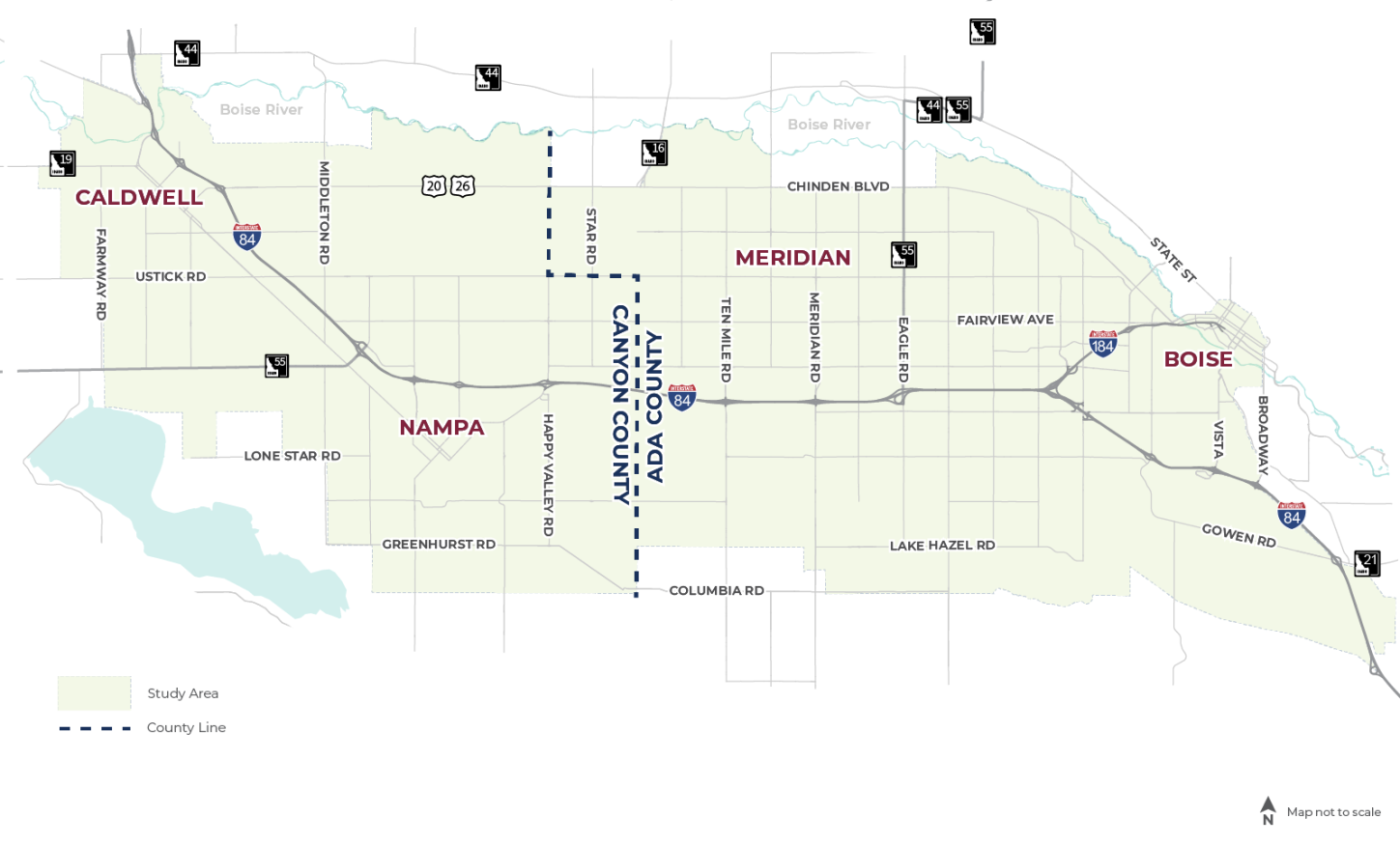High-Capacity Transit: Caldwell, Nampa, Meridian, Boise
Let’s Ride Treasure Valley Study (2024 – 2025)

NOTICE: This is a Planning and Environmental Linkages (PEL) study, and all draft and final planning products produced during this PEL process may be adopted during a subsequent environmental review process in accordance with 23 USC 168, with the goal of not revisiting during future National Environmental Policy Act (NEPA) processes.
Rapid population growth, increasing travel demand along east-west corridors, and deteriorating performance in the Interstate 84/Interstate-184 corridor have prompted COMPASS and its member agencies to study high-capacity transit options such as light rail, commuter rail, and bus rapid transit, that connect major activity centers in the Cities of Caldwell, Nampa, Meridian, and Boise.
The Let’s Ride Treasure Valley study kicked off in early 2024 and will examine a future high-capacity transit connection east to west across the Treasure Valley, south of the Boise River. High-level goals of the study include:
- Defining the purpose and need for potential high-capacity transit service
- Analyzing the technical feasibility, ability to meet the defined purpose/need, and public preference for various high-capacity transit options
- Identifying the benefits and impacts of those high-capacity transit options
- Removing infeasible options from further analysis
Purpose:
The purpose of the project is to improve the mobility, accessibility, and efficiency of east-west travel between Boise, Meridian, Nampa, and Caldwell, providing reliable and convenient high-capacity transit service that links key origins and destinations with strong potential for transit use.
Need:
- Lessen future stress on the region’s transportation infrastructure due to population and employment growth.
- Provide greater mobility choice given the region’s forecasted deteriorating transportation travel times.
- Support the region’s east-west travel patterns.
Figure: Study Area (click to access Interactive Master Map)
This project is different from past high-capacity transit planning efforts but will build on those efforts. This type of study, a “Planning and Environmental Linkages” or “PEL” study, is a formal (but early) step in the federal environmental process to begin to position a potential future project for federal funding. The lead federal agency for this study is the Federal Transit Administration (FTA).
While this study helps to position the project for some federal funding, local funding for high-capacity transit remains a significant obstacle. Idaho does not have a dedicated funding source for public transportation, which is needed to operate any sort of high-capacity transit system. Without dedicated funding, work on any type of high-capacity service will remain in the planning stages.
Even once funding is secured, the process to plan for, build, and begin operations for such a system will be long and time-consuming. Despite these obstacles, COMPASS will continue to plan, within funding limits, for a future high-capacity transit system.

Public Involvement
- Public Outreach #1 – September 24 – October 10, 2024
- Public Outreach #2 – February 10 – March 2, 2025
- Public Outreach #3 – June 6 – 29, 2025
Questions about the study or how you can be involved? Contact Austin Miller ([email protected]; 208/475-2239) or Amy Luft ([email protected] or 208/475-2229).
Study Materials
- Fall 2024 Open House Display Boards (Tier 1 Outreach)
- Fall 2024 Open House Display Boards, Text Only (Tier 1 Outreach)
- Public Comment/Outreach Summary, Fall 2024 (Tier 1 Outreach)
- Winter 2025 Open House Display Boards (Tier 2 Outreach)
- Winter 2025 Open House Display Boards, Text Only (Tier 2 Outreach)
- Winter 2025 Route Maps (Tier 2 Outreach)
- Winter 2025 Route Map Descriptions, Text Only (Tier 3 Outreach)
- Spring 2025 Outreach and Public Comment Summary (Tier 3 Outreach)
- Tier 3 Evaluation Summary
- Let’s Ride Treasure Valley (PEL Study) Interactive Master Map (click the layers tab in the left column to see the available layers)
Questions? Need Assistance?
- Email: [email protected]
- US mail: COMPASS, 700 NE 2nd Street, Suite 200, Meridian, ID 83642
- Request materials be mailed to you: 208/855-2558 or [email protected]
NOTICE: This is a Planning and Environmental Linkages (PEL) study, and all draft and final planning products produced during this PEL process may be adopted during a subsequent environmental review process in accordance with 23 USC 168, with the goal of not revisiting during future National Environmental Policy Act (NEPA) processes.
Past Planning (2009 – 2021)
COMPASS completed the first Treasure Valley High-Capacity Transit Study in 2009, then updated that study in 2020. In addition, COMPASS conducted a large-scale public survey in 2021 to better understand if and how residents would like to use high-capacity transit, including preferred destinations, timing, and types of service.
COMPASS staff used the survey results to identify trends, needs, and common destinations, then compared those to potential transit modes and alignments as identified in the Treasure Valley High Capacity Transit Study to identify options to best serve regional needs and preferences. Based on that analysis, regional rail on the Boise Cutoff alignment was identified as a “locally favored” option for the regional long-range transportation plan, Communities in Motion 2050.
Regional rail is a hybrid between commuter rail and light rail. Like commuter rail, regional rail uses the same heavy track infrastructure used by freight, but regional rail service is more like that of light rail, with more stations than a typical commuter rail system. While the region has expressed a preference for regional rail, additional analyses and input are needed to move forward with any option.
That past planning and analysis is being used to inform the 2024/2025 Let’s Ride Treasure Valley study.
Previous COMPASS High-Capacity (Caldwell, Nampa, Meridian, Boise) Transit Studies and Plans

